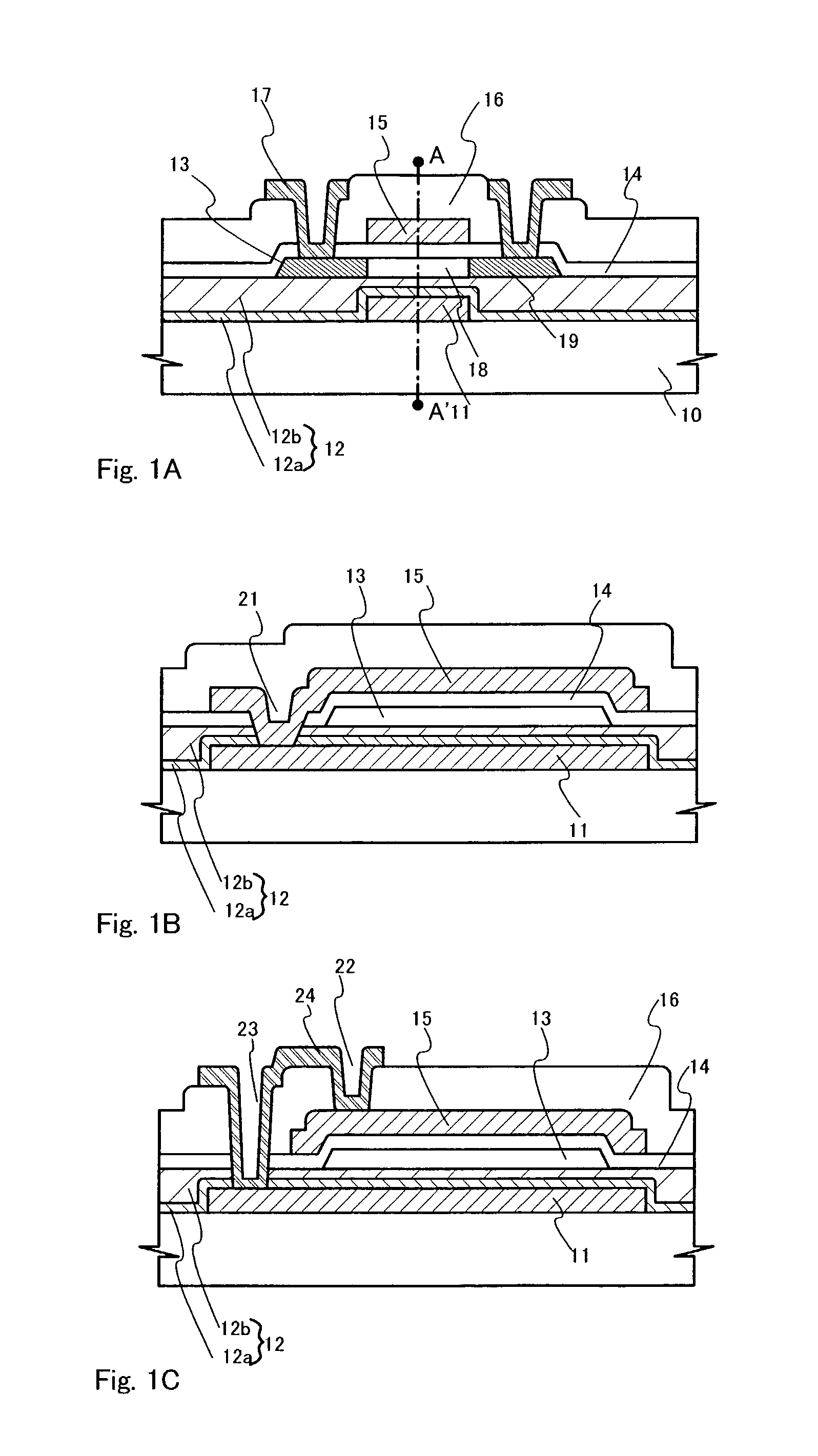Light emitting device
a technology of light-emitting devices and semiconductors, which is applied in the direction of semiconductor devices, electrical equipment, transistors, etc., can solve the problems of low electric field effect mobility of tft using amorphous silicon, inability to operate at the frequency required to process video signals, and limit in a system for mounting drivers i
- Summary
- Abstract
- Description
- Claims
- Application Information
AI Technical Summary
Benefits of technology
Problems solved by technology
Method used
Image
Examples
embodiment 1
[0083] (Embodiment 1)
[0084] In this embodiment, steps of manufacturing a semiconductor device according to the present invention will be described. In addition, a method of manufacturing TFT's for a pixel section will be described in detail here. Note that, this embodiment shows an example that a common voltage is applied to a first electrode on TFT used as a switching element (switching TFT) and the first electrode and a second electrode are connected to each other on TFT controlling current which flows to the light emitting element (driving TFT). Further, although the method of manufacturing TFT's for the pixel section is only described in this embodiment, TFT's for a driver circuit may also be manufactured simultaneously.
[0085] FIGS. 2 to 5 are cross-sectional views for explaining the semiconductor device manufacturing steps. FIGS. 6 to 8 are corresponding top views. For the convenience of explanation, common reference symbols are used therein.
[0086] In FIG. 2A, a substrate made ...
embodiment 2
[0127] (Embodiment 2)
[0128] In this embodiment, the construction of a pixel of the light emitting device of the present invention different from that in the embodiment 1 will be explained.
[0129] FIG. 9 shows a top view of the pixel of the light emitting device of this embodiment. FIG. 10 shows a sectional view in A-A', B-B' and C-C' of FIG. 9. A partition wall layer, an organic light emitting layer, a cathode and a protecting film manufactured in the process subsequent to the formation of a pixel electrode are omitted to clarify the construction of the pixel in FIG. 9.
[0130] Reference numeral 301 designates a TFT for switching, and an n-channel TFT is used in this embodiment. Reference numeral 302 designates a TFT for driving, and a p-channel TFT is used in this embodiment. The TFT for switching and the TFT for driving may be set to the n-channel TFT and the p-channel TUT.
[0131] The TFT 301 for switching has first electrodes 306, 307, a first insulating film 350 abutting on the firs...
embodiment 3
[0145] (Embodiment 3)
[0146] In this embodiment, the construction of a pixel of the light emitting device of the present invention different from that in the embodiments 1, 2 will be explained.
[0147] FIG. 11 shows a top view of the pixel of the light emitting device of this embodiment. FIG. 12 shows a sectional view in A-A', B-B', C-C' and D-D' of FIG. 11. A partition wall layer, an organic light emitting layer, a cathode and a protecting film manufactured in the process subsequent to the formation of a pixel electrode are omitted to clarify the construction of the pixel in FIG. 11.
[0148] Reference numeral 401 designates a TFT for switching, and an n-channel TFT is used in this embodiment. Reference numeral 402 designates a TFT for driving, and a p-channel TFT is used in this embodiment. The TFT for switching and the TFT for driving may be also set to the n-channel TFT and the p-channel TFT.
[0149] The TFT 401 for switching has first electrodes 406, 407, a first insulating film 450 ab...
PUM
 Login to View More
Login to View More Abstract
Description
Claims
Application Information
 Login to View More
Login to View More - R&D
- Intellectual Property
- Life Sciences
- Materials
- Tech Scout
- Unparalleled Data Quality
- Higher Quality Content
- 60% Fewer Hallucinations
Browse by: Latest US Patents, China's latest patents, Technical Efficacy Thesaurus, Application Domain, Technology Topic, Popular Technical Reports.
© 2025 PatSnap. All rights reserved.Legal|Privacy policy|Modern Slavery Act Transparency Statement|Sitemap|About US| Contact US: help@patsnap.com



